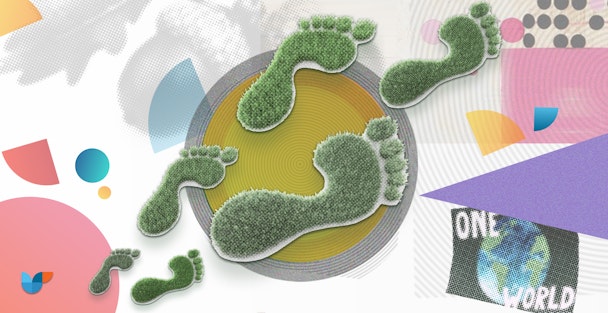5 ways to reduce your digital carbon footprint
Matt Gibson of digital agency Cyber-Duck casts his eye over some difficult findings about the climate costs of the digital estate – and five ways to begin clearing it up.

Do you know how big your digital footprint is? / Image courtesy of Cyber-Duck
With a climate emergency now declared internationally, the world is at a tipping point. But while we all know the importance of recycling, minimizing energy use and air travel, and other real-world actions, can we say the same for our digital activities? Although digital platforms and content aren’t tangible, their effect on the planet is all too real. Digital now produces more carbon emissions than aviation and is growing largely unchecked.
It can be difficult to know where to begin. Here are our suggestions for practical steps to digitally ‘reduce, reuse and recycle’.
Advertisement
1. Declutter your digital estate
There are an estimated 1.5bn to 1.9bn websites worldwide. The vast majority are inactive. Businesses often build new pages, sites, and microsites supporting new business objectives and functionality without removing old ones. The result? An unwieldy, messy digital estate with outdated content, dead-end user journeys, and a bloated carbon footprint. If this is true of your business, it’s time to tidy up.
Website consolidation involves reducing the number and size of websites and centralizing them onto fewer platforms. It should be based on holistic, user-centered research and content design. Investigate what users need, learn what’s no longer relevant and audit content to provide a solid direction for improved information architecture and user journeys. You’ll boost operational efficiency and save on hosting and software licensing costs.
Advertisement
2. Guide users toward their goals
User experience (UX) design and research are invaluable tools in the fight against digital pollution. Intuitive user journeys, accessibility, clear navigation and clearly signposted content all help users to reach their goals efficiently. Energy-guzzling frustration clicks, re-loading pages, repeated downloads, and replicated tasks will be significantly reduced. In turn, so will your carbon emissions. Capturing only necessary information in the process will enhance user privacy and minimize the costs of storing dark data.
3. Make mindful design choices
Conscious user interface (UI) design choices make a difference to UX and energy consumption. Over the last decade, the average page weight has grown from 484KB to a startling 2.2MB, largely due to the increased use of audio, video and image files. Being mindful of the type and size of the elements in your interface design will keep pages lighter and loading swiftly.
Compressing images and videos is a simple way to save energy. Be aware of the types and number of fonts you use; preinstalled system fonts use less energy than custom ones. Even color choices have an effect, due to the energy needed for illumination on OLED screens. Did you know blue pixels use around 25% more energy than red and green ones?
Suggested newsletters for you
4. Head to the cloud
Not long ago, businesses had to store data on energy-intensive physical servers that demanded uninterruptible power supplies and round-the-clock cooling fans. Today, there are green hosting services running on renewable energy in centralized data centers and cloud hosting eliminates the need for physical hardware on individual premises. Studies show that switching to cloud-based data storage can cut CO2 emissions by up to 50%.
Cloud hosting can help reduce downtime and increase the speed of data delivery. Our DevOps team recently shifted an entire digital ecosystem from physical servers to AWS cloud hosting for a major manufacturer. Site uptime increased from 96/97% to 99.9/100%, and average page load time halved from 6 seconds to 3 seconds, delivering a better user experience and conserving energy.
5. Slim down your code
The right tech stack can facilitate eco-friendly UX/UI design and help keep your website light and uncluttered. We often use the open-source CMS Drupal, which can support multiple products and designs from a single back-end system, streamlining the marketing and content production process and making it easy to maintain up-to-date, relevant content.
Meanwhile, lean code is a great way to reduce waste in software development. It helps developers focus on delivering only what’s necessary, avoiding excess code, features, and processes that don’t add value to the user. The goal is to create software quickly, with minimal resources, while maintaining high code quality and maintainability. Lean code can speed up page loading and cut down the processing power needed while increasing the velocity of work and enabling code to ship faster – making life better for users and developers alike while reducing environmental impact.
A focus on digital sustainability is brilliant for the planet and business alike. It’s ethically essential, can also boost brand and user experience, increase operational efficiency and in turn, increase ROI.
Content by The Drum Network member:

Cyber-Duck
Established in 2005, Cyber-Duck is a leading digital agency that works with exciting startups and global brands such as Cancer Research Technology, The European...
Find out more
